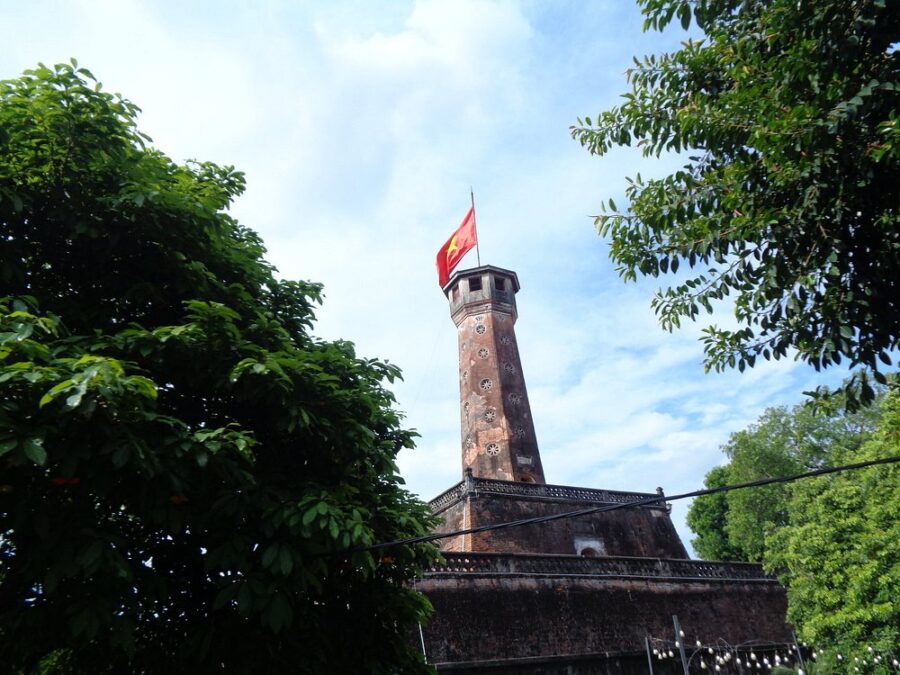
Hanoi Flagtower
Table of Contents
History and Significance

If you’re wandering the vibrant streets of Hanoi, the Hanoi Flag Tower pops up not just as a striking architectural sight, but as a towering witness to centuries of Vietnam’s storied past. Its roots stretch back to the early 19th century, constructed between 1805 and 1812 under Emperor Gia Long of the Nguyen Dynasty. This tower was no mere decoration—it was a strategic military observation post within the sprawling Thang Long Imperial Citadel, built to survey and protect the capital from invaders.
What’s truly captivating is how the tower has endured through the tumult of history. While much of the citadel was ravaged during the French colonial period, the French spared the Flag Tower, recognizing its strategic value. It served as a military lookout during various conflicts, including the Indochina War. The moment the Vietnamese national flag was hoisted atop the tower after the successful August Revolution in 1945, it became a profound symbol of resistance and freedom. Later, in 1954, after the historic victory at Dien Bien Phu, raising the flag again marked Hanoi’s liberation from colonial rule.
So when you stand before the tower today, you’re not just looking at bricks and mortar; you’re seeing the heart of Vietnam’s spirit, resilience, and hope. It’s an emblem stitched tightly into the fabric of Hanoi’s identity, proudly flying a flag that’s waved over the city for nearly 70 years now.
Main Attractions and Activities
Visiting the Hanoi Flag Tower is not just about admiring a tall structure. The tower itself rises 33.4 meters (around 108 feet) tall, with the flagpole adding another 8 meters or so, making it one of the highest historical towers in the city. Its three-tiered, octagonal design is fascinating—each tier tells a story of architecture meeting function. The robust brickwork was crafted with materials dating back to the Le Dynasty, ensuring it stood the test of time while serving as a military marvel.
Inside, there’s a tight, spiral staircase with 54 steps winding upwards, although visitors today are generally only allowed to explore up to the base and first levels as the upper sections need preservation work. If you’re lucky, you might catch the morning or evening light casting beautiful shadows, and there’s a certain coolness inside the tower thanks to its clever ventilation design involving 36 flower-shaped and six fan-shaped windows.
Just outside, the spacious courtyard is part of the Vietnam Military History Museum complex, where you can also explore fascinating exhibits like vintage tanks, helicopters, and aircraft—reminders of the many conflicts Hanoi has lived through. Taking a stroll here, with the flag fluttering above, you catch a real sense of national pride and Vietnam’s enduring story.
Visitor Experience
Now, if you’re expecting a crowded, touristy feel, you won’t necessarily get that here. The Flag Tower commands respect rather than spectacle. When I visited, I found it offered a peaceful, reflective experience. The setting allows a leisurely exploration of both the exterior architectural details and the nearby museum grounds. Although you can’t climb to the top inside the tower at the moment, just gazing up at the red flag with its golden star waving heroically in the breeze is stirring.
English signage around the site tends to be a bit sparse, something to prepare for if you’re not fluent in Vietnamese. However, the overall vibe and visuals speak volumes, and local guides or audio tours can fill in the gaps nicely if you want a deeper dive.
One thing to watch for is weather—Hanoi can be hot and sticky, so picking a cooler morning to visit will make your experience that much more comfortable.
Tips for Visitors
You want to get the most out of your visit, right? Here are a few practical nuggets from my time there:
-
Go early: Weekday mornings are your best bet to avoid any crowds and soak in the serenity.
-
Dress smartly: Lightweight, breathable clothes and comfy shoes are ideal for walking around the courtyard and cobbled paths.
-
Bring a camera: Even a smartphone camera will capture some stunning shots of the tower against Hanoi’s skyline. Bonus points if you have an Ao Dai to wear—it makes for iconic and beautifully nostalgic photos.
-
Stay hydrated: The area has a small café, but options are limited, so water on hand is a wise call.
-
Respect the atmosphere: This isn’t a theme park; it’s hallowed ground with heavy emotion and history. Keeping your tone quiet and respectful enhances the experience for everyone.
Accessibility and Facilities
The Hanoi Flag Tower and its surroundings are moderately accessible. The paths and grounds are generally flat and well-maintained. Wheelchair access is somewhat limited inside the tower itself due to its age and spiral staircases, but the exterior and museum grounds can be enjoyed by most visitors.
Facilities are basic but adequate. Clean restrooms are available on site, and there’s a modest gift shop offering souvenirs steeped in Vietnamese history rather than the usual tourist tchotchkes.
Unique Features
The Flag Tower’s uniqueness lies in its blend of architectural ingenuity and historical symbolism. Its three-tiered brick structure is both beautiful and functional, ventilated naturally through numerous ornate openings—an ingenious adaptation to the Vietnamese climate. The tower’s octagonal top chamber with eight windows oriented to the cardinal directions is more than aesthetic; it’s about surveillance and security, a watchman’s post frozen in time.
Then there’s the sheer symbolism of the towering national flag, one of the largest in Hanoi, replaced every few weeks to keep the colors vibrant—standing tall atop a site that survived colonial destructions and war, continuing to represent peace and national unity.
Overall Impressions
Standing in front of the Hanoi Flag Tower feels like an intimate conversation with history. It isn’t just a dusty relic; it pulses with Vietnam’s enduring pride, resilience, and hope. Though small in scale compared to massive complexes, its significance feels enormous.
Visiting it offers you a pause—a chance to reflect on Hanoi’s layered past while witnessing an iconic symbol still proudly waving above the city’s bustling present. If you’re a keen history lover or someone who appreciates heritage woven seamlessly into city life, this tower will sink deep into your memories.
Pros and Cons
Pros:
-
Rich historical context with ties to multiple eras of Vietnam’s story
-
Architecturally striking with clever design and symmetry
-
Located centrally, easy to access from elsewhere in Hanoi
-
Calm, reflective visitor experience with a connection to the surrounding military museum
-
Free or low-cost entry to temple grounds and museums
Cons:
-
Limited English signage inside the tower and surrounding exhibits
-
The top of the tower is usually closed for preservation, limiting panoramic views
-
Facilities and amenities are basic; a small café with limited offerings
-
Not a lively, bustling tourist attraction, so you may feel quiet or subdued if you prefer crowds
So, next time you’re in Hanoi, don’t just rush past the Hanoi Flag Tower. Take the time to let it whisper its many stories to you—from its sturdy Le Dynasty bricks to the flags that flutter with the spirit of a nation refusing to bow. It’s a spot that teaches patience, pride, and history all at once. Put it on your list, and you won’t regret it.
Location
Places to Stay Near Hanoi Flagtower
Find and Book a Tour
Explore More Travel Guides
No reviews found! Be the first to review!